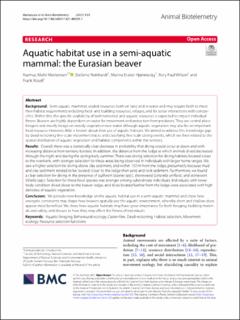| dc.contributor.author | Mortensen, Rasmus Mohr | |
| dc.contributor.author | Reinhardt, Stefanie | |
| dc.contributor.author | Hjønnevåg, Marina Eraker | |
| dc.contributor.author | Wilson, R. P. | |
| dc.contributor.author | Rosell, Frank | |
| dc.date.accessioned | 2022-03-17T12:36:20Z | |
| dc.date.available | 2022-03-17T12:36:20Z | |
| dc.date.created | 2021-08-30T14:37:10Z | |
| dc.date.issued | 2021 | |
| dc.identifier.citation | Mortensen, R. M., Reinhardt, S., Hjønnevåg, M. E., Wilson, R. P. & Rosell, F. (2021). Aquatic habitat use in a semi-aquatic mammal: the Eurasian beaver. Animal Biotelemetry, 9, Artikkel 35. | en_US |
| dc.identifier.issn | 2050-3385 | |
| dc.identifier.uri | https://hdl.handle.net/11250/2985855 | |
| dc.description.abstract | Background: Semi-aquatic mammals exploit resources both on land and in water and may require both to meet their habitat requirements including food- and building resources, refuges, and for social interactions with conspecifics. Within this, the specific availability of both terrestrial and aquatic resources is expected to impact individual fitness. Beavers are highly dependent on water for movement and protection from predators. They are central place foragers and mostly forage on woody vegetation near water although aquatic vegetation may also be an important food resource. However, little is known about their use of aquatic habitats. We aimed to address this knowledge gap by dead-reckoning fine-scale movement tracks and classifying fine-scale diving events, which we then related to the spatial distribution of aquatic vegetation and habitat components within the territory.
Results: Overall, there was a statistically clear decrease in probability that diving would occur at dawn and with increasing distance from territory borders. In addition, the distance from the lodge at which animals dived decreased through the night and during the spring/early summer. There was strong selection for diving habitats located closer to the riverbank, with stronger selection for these areas being observed in individuals with larger home ranges. We saw a higher selection for diving above clay sediment, and within 150 m from the lodge, presumably because mud and clay sediment tended to be located closer to the lodge than sand and rock sediment. Furthermore, we found a clear selection for diving in the presence of quillwort (Isoetes spp.), shoreweed (Littorella uniflora), and stonewort (Nitella spp.). Selection for these focal species was stronger among subordinate individuals. Individuals with lower body condition dived closer to the beaver lodge, and dives located further from the lodge were associated with high densities of aquatic vegetation.
Conclusion: We provide new knowledge on the aquatic habitat use in a semi-aquatic mammal and show how energetic constraints may shape how beavers spatially use the aquatic environment, whereby short and shallow dives appear most beneficial. We show how aquatic habitats may have great importance for both foraging, building materials and safety, and discuss to how they may affect the fitness of individuals. | en_US |
| dc.language.iso | eng | en_US |
| dc.rights | Navngivelse 4.0 Internasjonal | * |
| dc.rights.uri | http://creativecommons.org/licenses/by/4.0/deed.no | * |
| dc.title | Aquatic habitat use in a semi-aquatic mammal: the Eurasian beaver | en_US |
| dc.type | Peer reviewed | en_US |
| dc.type | Journal article | en_US |
| dc.description.version | publishedVersion | en_US |
| dc.rights.holder | © The Author(s) 2021. | en_US |
| dc.source.volume | 9 | en_US |
| dc.source.journal | Animal Biotelemetry | en_US |
| dc.identifier.doi | https://doi.org/10.1186/s40317-021-00259-7 | |
| dc.identifier.cristin | 1929809 | |
| dc.source.articlenumber | 35 | en_US |
| cristin.ispublished | true | |
| cristin.fulltext | original | |
| cristin.qualitycode | 1 | |

